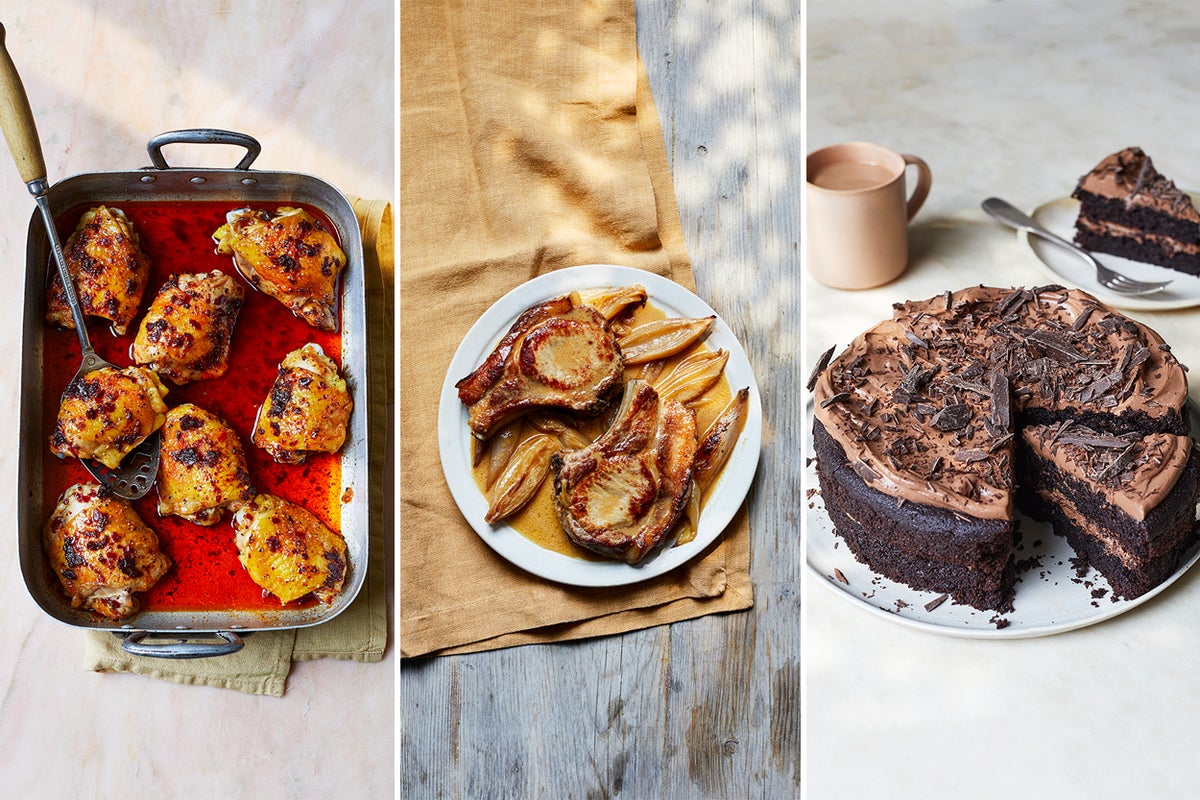
Your support helps us to tell the story
This election is still a dead heat, according to most polls. In a fight with such wafer-thin margins, we need reporters on the ground talking to the people Trump and Harris are courting. Your support allows us to keep sending journalists to the story.
The Independent is trusted by 27 million Americans from across the entire political spectrum every month. Unlike many other quality news outlets, we choose not to lock you out of our reporting and analysis with paywalls. But quality journalism must still be paid for.
Help us keep bring these critical stories to light. Your support makes all the difference.
Once in a generation, a cookbook appears that aims to do more than just sit on a shelf and gather dust. You Can Cook Everything is that book – the kind that ends up dog-eared and splattered with sauce in kitchens across the country.
Naturally, comparisons to Delia Smith’s classic cookbooks have been thrown around – though You Can Cook Everything isn’t the work of just one ultra-famous chef doling out kitchen commandments. It’s a collective effort, featuring the likes of Riaz Phillips, Verna Gao, Jodie Nixon, Karla Zazeuta and Idy Osibodu – names you’re more likely to double-tap on Instagram than find in the cookery aisle at Waterstones, though they deserve just as much shelf space.
“Honestly, what an honour to be spoken about in the same breath as the culinary queen,” says Sophie Godwin, a little incredulous, who, alongside partner Adam Bush, contributed the bulk of the recipes. “I would always ask my grandma for her recipe for something and nine times out of 10, it would be Delia’s.” Perhaps You Can Cook Everything, then, is somewhat of a sequel to How To Cook. “This cookbook is a similar premise, but the recipes and techniques are more in line with what people cook now, notably a more global diet.”
That global focus is key to You Can Cook Everything. You won’t just find your Sunday roasts and Victoria sponges. Here, harissa rubs shoulders with soy sauce and the humble chicken thigh gets a North African makeover. “When it comes to the global recipes, we wanted to make sure that the cuisine was properly represented,” Bush explains. “We worked with some brilliant contributors from around the world to ensure this happened. The more challenging thing was what to leave out because, honestly, there could be a whole other 275 delicious recipes!”
Yes, the scope of the book is vast, but sharply focused. Each chapter is organised by ingredient, so you can start with something as simple as boiling an egg before working your way up to making a hollandaise sauce or mastering fresh pasta. “It feels like everything we have cooked and written has led us up to this point,” Godwin says. “Adam’s Michelin-star training and work as a baker heavily influenced the meat, fish and bread chapters, while I drew on my experiences ghostwriting to make the recipes as accessible as possible.”
And it shows. The book is designed for all levels, a feat not to be sniffed at. The recipes aren’t just about teaching you how to cook – they’re about giving you the confidence to enjoy the process. “We want people to come away feeling like cooking is fun,” says Bush. “Be it making your flatmates some harissa roast chicken thighs for the first time, or embarking on making your own filled pasta. How you use it is up to you – some people love to follow recipes exactly, while others may use it to gain confidence and then go completely off the wall.”
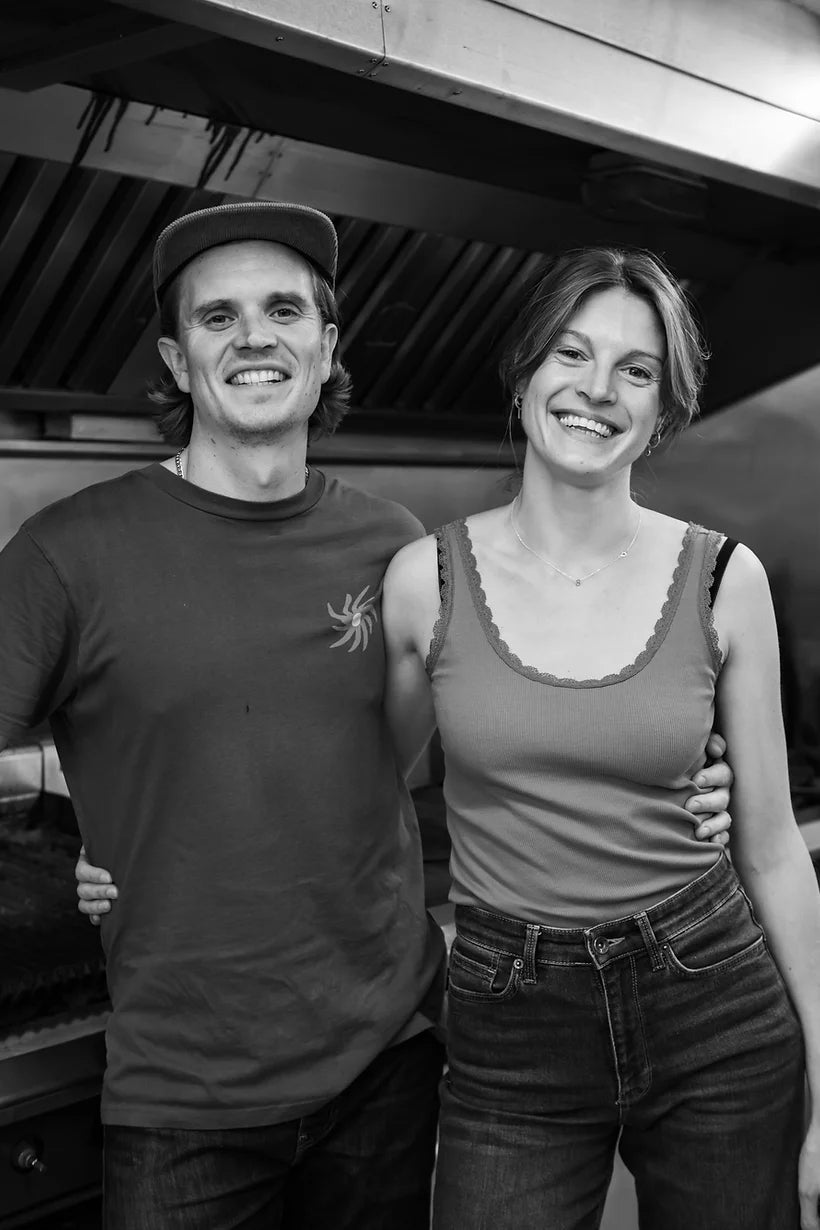
Bush’s pride and joy are the meat cooking tables. In a world where everyone is terrified of overcooking – or worse, undercooking – their roast, the tables offer clarity. “Ultimately, many years of cooking big pieces of meat stood us in good stead, but there was also an awful lot of cooking and honing and testing until we were happy that they would work for everyone,” he explains.
Ask them about their favourite recipes and you’ll get two very different answers. Bush, ever the meat man, has no hesitation: “The pork chop with miso lime butter shallots, because it is exactly what I would cook myself for dinner every night if I could,” he says, with a relish that suggests he very often does. Godwin, always one to defy expectations, champions her vegan chocolate cake. “For the sheer fact no one will believe it’s vegan.” And there’s the balance – indulgent, ethical, full of flavour.
Of course, there’s much more to You Can Cook Everything than just a collection of recipes. It’s a manifesto for kitchen confidence. Bush’s essential technique? “Roasting a chicken and then making stock. ALWAYS keep and boil your bones. You are cheating the system with all that free flavour.” Godwin champions the herb chapter. “Learning how to make green sauces, pesto and using herbs with cavalier abundance is the way I love to cook. It can elevate even the most basic of dinners.”
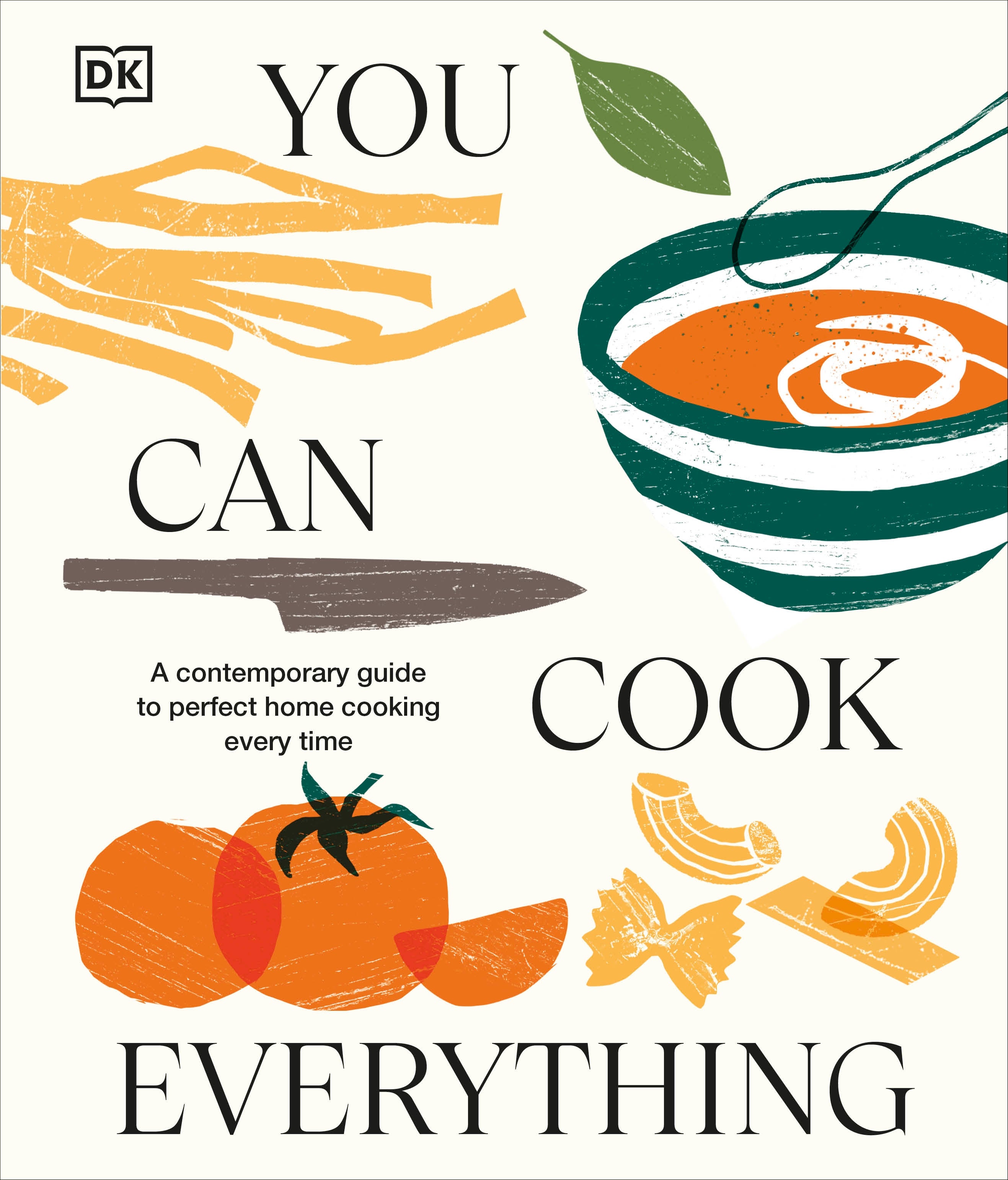
Of course, writing a book of this scale wasn’t without its challenges. Much of it was written while Godwin was pregnant with their son, Rudy, and Bush is quick to point out the dedication it took. “I’ve learnt that my wife is a literal superwoman,” he says proudly.
Perhaps that’s why they’ve created something that feels both modern and timeless. “We have so many more ingredients available to us nowadays, so the recipes reflect that,” says Godwin. “Hot sauce, harissa and such like are used where they add loads of banging flavour. Other times, they are simply not needed, and classic is best – so I suppose by focusing on making each recipe the most tasty it could be, we struck the balance between classic and modern. After all, a spag bol will never go out of fashion!”
You Can Cook Everything is the kind of cookbook that bridges the gap between the familiar and the adventurous. It’s equally happy holding your hand through a Sunday roast as it is taking you on a journey through flavours you’ve never dared try before. It doesn’t just teach you to cook, but teaches you to enjoy it. And really, isn’t that the point?
Harissa sticky chicken thighs
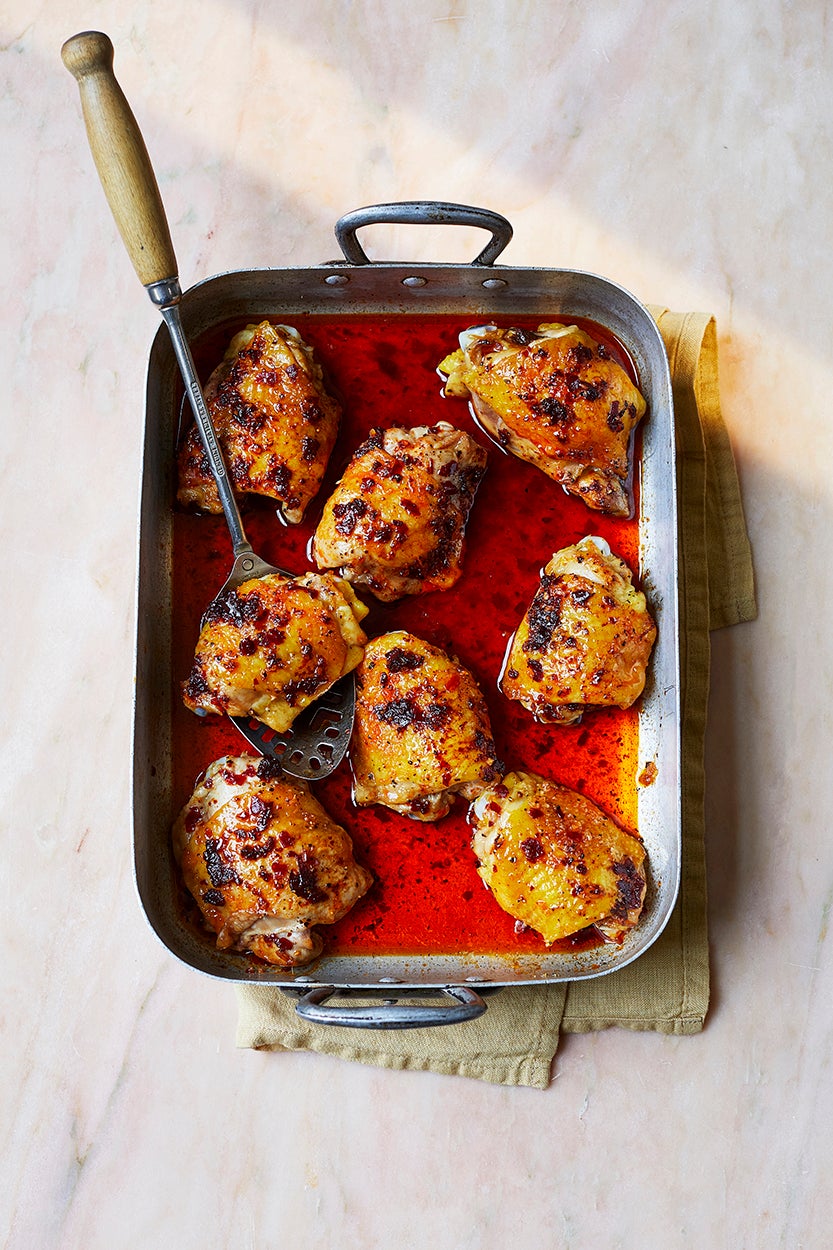
These chicken thighs are sure to become one of your recipe staples. Once roasted, they have a crispy, sticky skin with soft, unctuous meat. This recipe calls for longer, slower cooking at a lower oven temperature as the harissa and honey coating can burn if the oven is too high. Harissa is a chilli paste originating from North Africa and gives the thighs a spicy, sweet flavour with a hint of rose.
Serves: 4
Prep time: 5 minutes | Cooking time: 45 minutes
Ingredients:
8 whole skin-on, bone-in chicken thighs
1 tbsp vegetable oil
3 tbsp rose harissa
1 tbsp runny honey
Salt and freshly ground black pepper
Method:
1. Preheat the oven to 200C (180C fan/400F/gas 6). Tip the chicken thighs into a large roasting tray, drizzle over the oil and season generously with salt and pepper. Put the tray in the oven for 20 minutes, until the skin begins to crisp.
2. Remove the chicken thighs from the oven and add the harissa. Mix well until the chicken is evenly coated in the oil and harissa, then put the tray back into the oven for 20 minutes, until the chicken skin is crisp and golden.
3. Drizzle the honey over the thighs and roast for another 5 minutes, until they are sticky and glazed.
Pork chops with miso lime-butter shallots
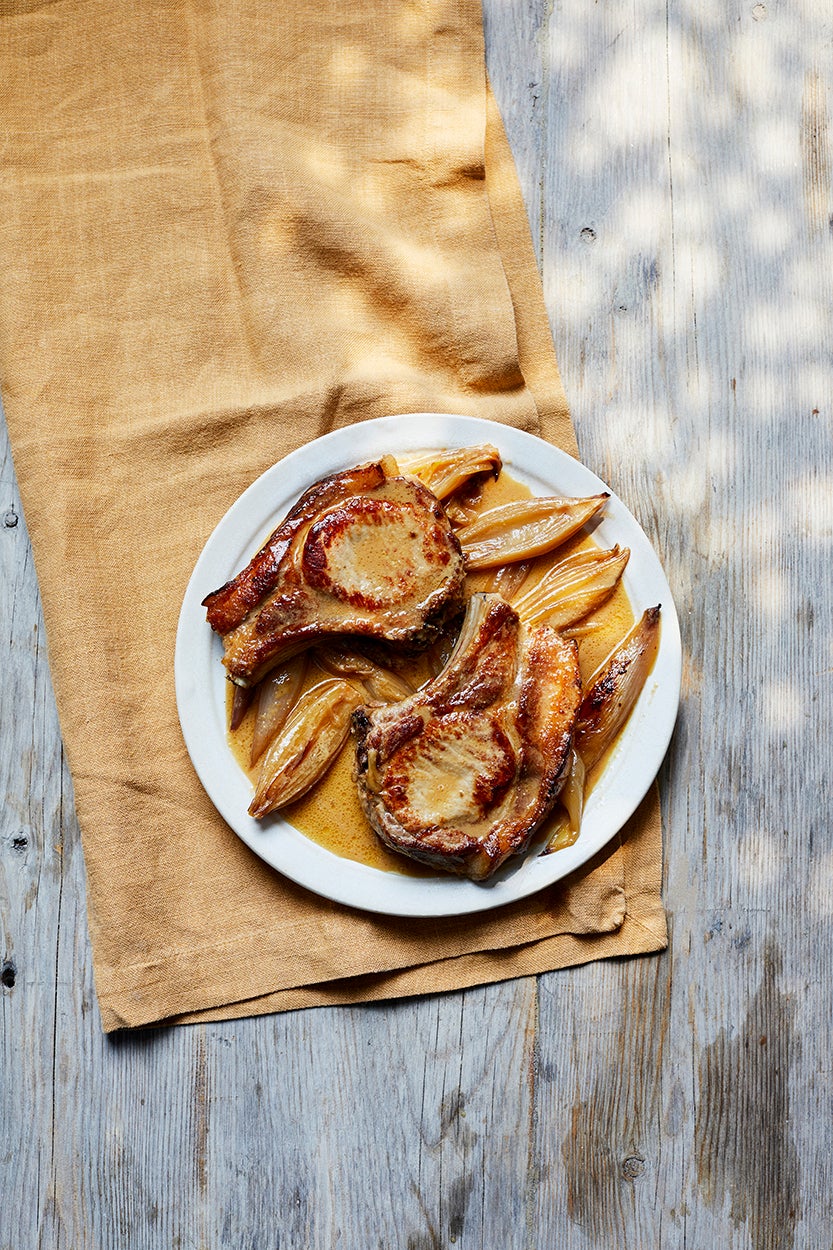
This recipe is all about rendering that delicious pork fat. Initially holding the chop upright on its fatty side while it cooks draws the fat out, basting the meat once it is placed on its flat side in the pan, becoming crisp and golden at the same time. Don’t be scared of getting the pan super hot – the high heat chars the pork adding to its flavour. The lime helps to cut through the richness of the pork fat, while the buttery miso sauce holds everything together.
Serves: 2
Prep time: 5 minutes | Cooking time: 40 minutes
Ingredients:
1 tbsp olive oil
4 banana shallots, trimmed, peeled and cut in half lengthways
50g (1¾oz) salted butter, melted
250ml (9fl oz) Chicken Stock
2 tbsp white miso
2 bone-in pork chops
Juice of 1-2 limes
Salt and freshly ground black pepper
Method:
1. Preheat the oven to 200C (180C fan/400F/gas 6).
2. Pour half the olive oil into a medium frying pan set over a medium-high heat. Add the shallots to the pan, cut-side down, and fry for 4–5 minutes, until charred and golden. Flip the shallots over and repeat on the other side, then place in a small, deep roasting tray.
3. Whisk together the melted butter, stock and miso, then pour the mixture over the shallots. Roast in the oven for 25 minutes.
4. Meanwhile, pour the remaining oil over the pork chops and season well with salt.
5. Place the frying pan back on a high heat. Using tongs, hold the pork chops fat-side down in the pan for 1 minute, until caramelized. Lay each pork chop onto one side and fry for 2 minutes, then flip and repeat until golden.
6. Remove the shallots from the oven, squeeze in the juice of 1–2 limes, depending on preference, and season with salt and pepper. Nestle in the pork chops and return the tray to the oven to roast for 5 minutes, until the pork is cooked through.
7. Remove the pan from the oven and allow the pork to rest for a few minutes. Serve the pork with the roast shallots and any sauce left in the tray along with a salad on the side, if you like.
Vegan chocolate cake
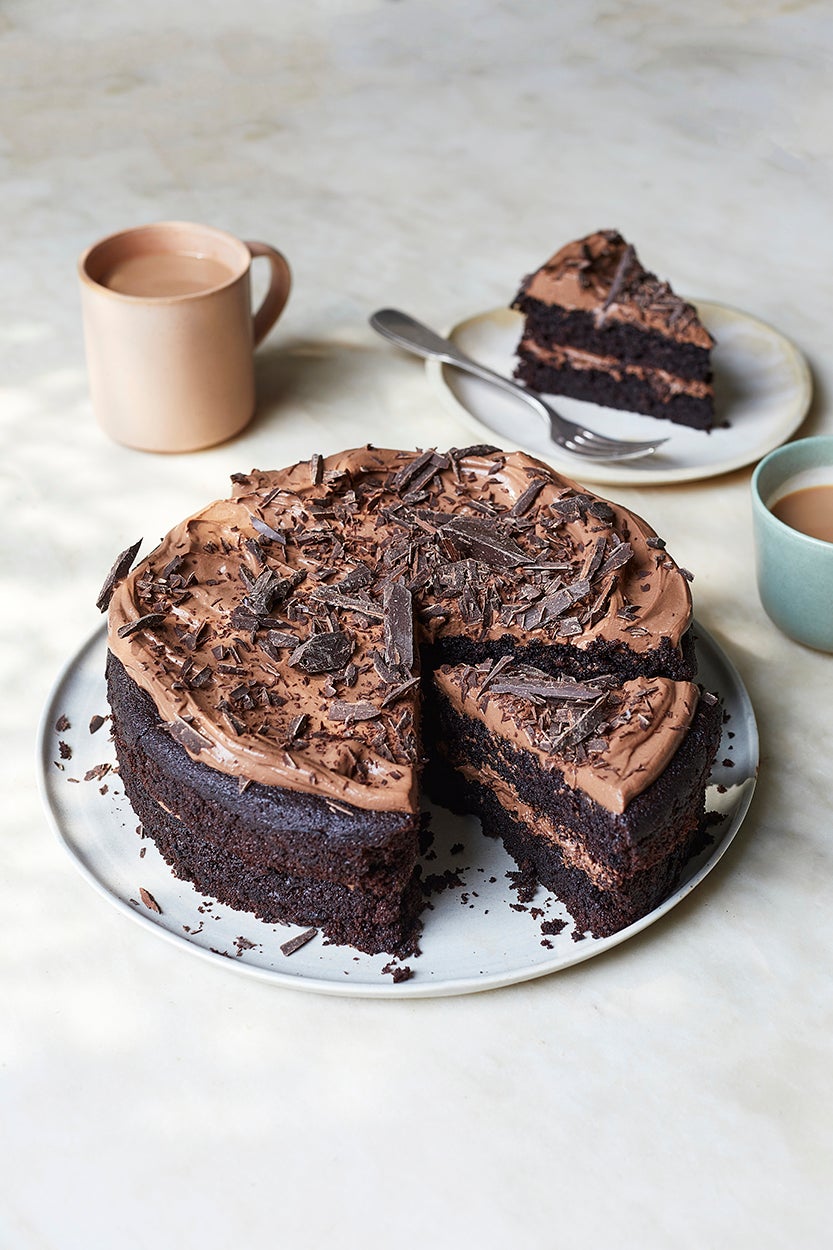
This all-in-one vegan chocolate cake doesn’t rely on hard-to-find, expensive ingredients. Instead, it uses vegetable oil with non-dairy milk and lemon juice to create a type of vegan buttermilk that reacts with the flour and raising agents to create a rise, without the need for eggs. The fudgy cake is then finished with the smoothest tofu frosting, which is almost like a chocolate mousse in texture.
Serves: 8-10
Prep time: 20 minutes, plus cooking | Cooking time: 40 minutes
Ingredients:
175ml (6fl oz) vegetable oil, plus extra for greasing
300ml (10fl oz) non-dairy milk of choice
Juice of ½ lemon
250g (9oz) soft light brown sugar
80g (23⁄4oz) cocoa powder
220g (7½oz) self-raising flour
1 tsp bicarbonate of soda
½ tsp salt
4 tsp just-boiled water
50g (1¾oz) vegan plain chocolate, roughly chopped, to decorate
For the frosting:
125g (4½oz) vegan plain chocolate, chopped
2 tbsp soft light brown sugar
300g (10oz) silken tofu, drained
1 tsp vanilla paste or extract
Pinch of salt
Method:
1. Preheat the oven to 180C (160C fan/350F/gas 4). Lightly grease the sides and base of 2 x 20cm (8in) springform cake tins with oil, then line the base of each with a disc of baking paper.
2. Using a fork, whisk the non-dairy milk with the lemon juice in a jug. Leave for 5 minutes to lightly curdle into a type of buttermilk.
3. In a large mixing bowl, sift in the sugar, cocoa powder, flour, bicarbonate of soda and salt, then mix until combined.
4. Pour the buttermilk mixture and vegetable oil into the dry ingredients, whisking well to make a smooth cake batter. Finally, whisk in the just-boiled water – this is the secret to a fudgy chocolate cake batter. Divide the batter evenly between the prepared tins.
5. Bake on the middle shelf of the oven for about 40 minutes, until well risen, springy to the touch and a metal skewer inserted into the centre comes out clean. Leave the cakes in their tins for 15 minutes, then transfer to a wire rack to cool completely.
6. To make the frosting, melt the chocolate in a microwave-safe bowl in 30-second intervals or in a heatproof bowl set over a pan of gently simmering water. Pour the melted chocolate into a blender with the sugar, tofu, vanilla and a pinch of salt and blend to make a smooth frosting. You may need to scrape down the sides of the blender a couple of times to combine. Chill in the fridge for about 15 minutes, until thickened slightly.
7. To assemble the cake, place one of the sponges, domed-side down, on a serving plate. Spoon half of the chocolate frosting on top and spread with a spatula into an even layer. Top with the second sponge and cover with the remaining frosting. Decorate the top with the sliced plain chocolate and cut into 8-10 slices, to serve. The cake will keep for up to 1 week in an airtight container in a cool place.
‘You Can Cook Everything’ (DK, £30).







